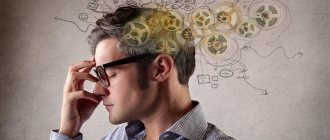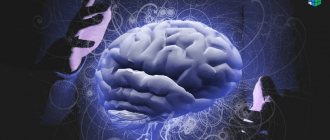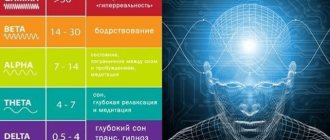Lesson plan:
What is consciousness
Individual and social consciousness
Self-awareness
Self-esteem of personality
The sphere of the unconscious: cognition and its levels
Unlike animals, people are able to realize what is happening to them and change the current situation. People understand that their every word and action will have certain consequences, so a person is able to restrain his instincts, passions, and emotions. Such self-control is possible due to the presence of consciousness in people.
What is consciousness
Consciousness is the highest level of mental activity, which allows a person to perceive the world around him and the events occurring in it, comprehend and evaluate them. Thanks to the presence of consciousness, a person is able to cognize not only the world around him, but also himself, evaluate his own thoughts, words, behavior, appearance. The opportunity to see oneself from the outside, a person’s ability for self-contemplation, provides him with a chance to change for the better, develop and improve himself.
Thanks to the development of the individual’s consciousness, he gradually develops a scientific picture of the world, develops his own system of values, and develops the ability for logical thinking and memory. Consciousness allows people to make the transition from passive living in this world to its transformation, thus, a person turns into the creator of his own reality, constantly influencing the nature and society around him.
You can understand how consciousness is formed by observing the development of the child’s psyche. So, for example, at the age of 1-2 years, children are actually not able to recognize themselves in the mirror, and after 3-4 years they can not only recognize themselves, but can also evaluate their appearance and behavior.
Without the development of consciousness, an individual cannot be a person in the full sense of the word, because consciousness performs many significant functions:
- Cognitive – consciousness is necessary to understand the world around us, people, and oneself. Cognition is carried out through sensory perception, sensations, and logical thinking. Depending on whether cognition is carried out with the help of feelings or reason, it is customary to distinguish between sensory and rational cognition.
- Analytical - with the help of consciousness, people analyze the events of their lives, events in the political, economic, social life of society, their own actions and the behavior of others.
- Evaluative - a person evaluates himself and the people around him, evaluates life circumstances and events as pleasant or unpleasant, good or bad, desirable and undesirable.
- Creative – thanks to the presence of consciousness, people are capable of constructive, creative activity. Only man can create works of art, discover scientific laws and theories, and invent ways to cure many diseases.
- Educational – with the help of consciousness, people pass on their experience to future generations, teach them through the knowledge accumulated by society.
Consciousness as a function of the human brain
Modern science proceeds from the ideas of the biological unity of animals and humans. From this, conclusions are sometimes drawn about the complete analogy of mental processes in humans and animals. But human consciousness arose and developed in close dependence on the formation and development of the human brain, as indicated by the fact that the level of complexity of the organization of the brain depends on the level of the reflexive ability of consciousness.
The main function of the human brain is the storage and processing of information that a person receives in the process of cognitive activity. The human brain is symmetrical (hemispheres), but there is a big difference between the hemispheres in terms of functionality.
The left hemisphere is responsible for all types of language activity (understanding, speech), ensures the processes of speech and writing, reading, performs counting operations, and assigns an object to certain classes.
The right hemisphere controls orientation in one's own body (perception of spatial relationships, correct coordination).
Consciousness not only reflects reality, but also allows us to express certain relationships with it. Therefore, the structure of consciousness includes: memory, emotions, feeling, will, motivation.
Individual and social consciousness
There are two main forms of consciousness - individual and social. Individual - represents part of the mental activity of an individual; it is the spiritual world of the individual, with his own thoughts, ideas, attitudes, feelings, experiences, views on the world around him. Each person has his own unique individual consciousness, which is formed in the process of interaction of the individual with the world around him and society.
Collective consciousness, or as it is also called social consciousness, is the totality of all the mental activities of people: their ideas, values, views, convictions, beliefs, traditions, interests, morals. Collective consciousness exists in small groups of people (for example, interest groups) , and among entire peoples, nations, all the inhabitants of planet Earth combined.
The public consciousness of people is usually divided into scientific, everyday, political, economic, religious. It affects every individual living in a given society, and at the same time, each individual makes his own contribution to the development of social consciousness.
Functions and properties
The psychological characteristics of consciousness are typical. They have specific properties that allow an individual to study and interact with the world around them:
- activity - the internal state of the individual encourages sustainable activity;
- intentionality - focus on a specific object;
- reflection - allows you to know yourself;
- motivational-value character - consciousness is always aimed at achieving results.
The development of consciousness is possible only through social contacts. Psychologists believe that the development of cognition is associated with the emergence of speech. At first it becomes a way of communication, then a means of thinking.
In addition to the general concept, the following types of consciousness are distinguished:
- everyday - primitive, develops in the process of primary study of the world;
- project - aimed at solving everyday problems and work tasks;
- scientific - comprehensive study of the world;
- aesthetic - aimed at emotional saturation, the process of transforming the world;
- ethical - control of behavior in accordance with the moral principles of the individual.
The development of consciousness continues in parallel with the process of evolution. Scientific and technological progress has significantly accelerated it. It can be assumed that in the future the speed of development will become even higher.
Self-awareness
An individual’s awareness of himself, his thoughts, appearance, character, actions, personal qualities is called self-awareness. The ability to self-awareness distinguishes people from animals, allows them to evaluate their personal qualities and, based on these assessments, change their character and habits.
Personal self-awareness begins with the child’s perception of his own appearance, some physical data and features. Gradually, in the process of self-awareness, the individual develops a whole system of ideas about himself, his inner world, his own place in society. Life experience, emotional and mental experiences leave their mark on every individual living in society. Each individual has his own, unique experience of life, so there are no people in the world with the same character, value system, or worldview.
Since the development of self-awareness occurs as a result of an individual’s interaction with the people around him, his ideas about himself largely depend on public opinion, regardless of whether it is objective or not.
Example 1. Masha Smirnova, a 14-year-old girl, considers herself an uninteresting person with an unattractive appearance. Masha formed this idea of herself under the influence of the ridicule of her classmates. However, Masha's peers criticized her appearance and behavior insincerely; they were simply jealous of the beauty of their classmate, with whom several boys from their class were in love.
Example 2. Tanya Mikhalchuk considers herself a very talented and capable person, since her parents constantly praise her and admire her creative and academic achievements. Teachers know that Tanya has very average abilities, but thanks to her self-confidence and diligence, she achieves good results in her studies.
It can be noted that in the first case, the individual’s self-esteem is clearly underestimated, and in the second, it is overestimated. Let's figure out what self-esteem is, because it is very closely related to human self-awareness.
Structure
There are 3 levels of knowledge. A person has a lower level since childhood, which increases with age. If this does not happen, the individual remains with a lower level of consciousness. He perceives the world like a child and is incapable of building normal relationships.
Each level has its own typical features:
- High level. A person who has reached the highest form of development is characterized by strong intuition, high intelligence, objectivity, and developed analytical thinking. The speed of development depends on external circumstances and activities. Individuals engaged in intellectual work develop faster. They are more prone to reflection and in-depth analysis of phenomena. Development occurs faster for people working in the creative field. Developed intuition is a necessary quality for successful activities. Such people, already at an early age, differ from their peers in that they cope faster with learning new information and solving complex problems. Such people make up no more than 15% of the total number.
- Average level. It is common to most people. This level of consciousness is enough to satisfy life's needs. People with an average level of development are busy solving only their own problems. They are not interested in philosophical questions; their level of intelligence and awareness does not allow them to operate with such categories of knowledge.
- Low level. Occurs in 20–25% of people over 18 years of age. Such people are considered ignorant and intellectually undeveloped. They are not interested in self-development. All interests are aimed at achieving pleasure without assessing the consequences of their actions. People with a low level of development have primitive thinking, which is usually characteristic of preschool children.
Cognition is dynamic. If desired, an individual can independently develop it and reach a high level. The older he gets, the more difficult it is to rebuild the process of studying the world and stimulate its development.
Self-esteem
Self-esteem is an individual’s opinion about himself, his assessment of his own qualities, strengths and weaknesses, which is based on comparing himself with other people. Unlike self-awareness, self-esteem always involves evaluation, comparison, juxtaposition, and the presence of an outside view of oneself. A person’s self-esteem is an integral part of self-awareness, but self-awareness can exist in its pure form, without self-esteem.
Psychologists distinguish three main types of personality self-esteem:
- Suspended self-esteem is a person’s biased ideas about himself, assessing only his own merits and actually ignoring his shortcomings. On the one hand, high self-esteem gives an individual self-confidence, helps him achieve his goals and objectives (after all, the more faith a person has in his own abilities, the more strong-willed and purposeful he becomes). On the other hand, an inflated level of self-esteem does not allow a person to develop, because people, confident that they know and can do everything, stop learning from others, thus, they begin to gradually degrade.
- Low self-esteem is an individual’s distorted perception of himself, due to which he cannot see his own merits and focuses only on his shortcomings. In this case, the influence of self-esteem has an even more detrimental effect on personality development than in the case of inflated self-esteem. An individual with low self-esteem experiences discomfort in communicating with others (after all, he constantly compares himself with others and finds that he is much worse than others), feels inferior, unworthy, and does not believe in his own strength. People with low self-esteem cannot fully realize their talents and abilities, and are afraid to set high goals for themselves and achieve them.
- Adequate self-esteem is an individual’s objective perception of himself, an assessment of his own strengths and weaknesses that is close to reality. A person with such self-esteem knows that there are people superior to him in qualities, and there are people who have not yet reached the same level of development as himself. In this case, self-confidence cannot become excessive, since the person sees and recognizes his shortcomings and strives to correct them.
- 1. Consciousness and its properties. Types of consciousness
- 2. Self-awareness. Structure of consciousness. "I-concept"
- 3. The relationship between consciousness and the unconscious
Lecture 4. Consciousness
1. Consciousness and its properties. Types of consciousness
As a result of evolution, the nervous system and, first of all, the brain have reached a level of development that allows a person to engage in work. Under the influence of labor of a collective nature, a person began to develop mental processes that led to the emergence of consciousness - the highest level of mental development inherent only to man. Thus, the emergence of consciousness in humans has both biological and cultural-social conditionality, i.e., the emergence of consciousness outside of society is impossible. The main conditions for the emergence and development of consciousness are the appropriate level of biological development, the presence of a social environment and collective work.
Consciousness
– the highest level of mental reflection and regulation, inherent only to man as a socio-historical being. From a practical point of view, consciousness can be considered as a continuously changing set of sensory and mental images that directly appear before the subject in his inner world and anticipate his practical activity. Consciousness is studied by many sciences - philosophy, anthropology, neurophysiology, sociology, psychology, physiology, etc. All religions pay close attention to consciousness.
From a psychological point of view, we can talk about several established properties of consciousness:
1) the consciousness of an individual is characterized by activity, which is determined primarily by the specific internal state of the subject at the moment of action, as well as by the presence of a goal and sustainable activity to achieve it;
2 consciousness is characterized by intentionality[25], i.e., direction towards some object. Consciousness is always consciousness of something;
3) the ability of human consciousness for reflection[26], introspection, i.e. the possibility of awareness of consciousness itself;
4) consciousness has a motivational and value character. It is always motivated, pursuing some goals, which is determined by the needs of the body and personality.
One of the functions of consciousness is the formation of goals of activity, the preliminary mental construction of actions and the anticipation of their results, which ensures reasonable regulation of human behavior and activity. Consciousness developed in humans only in social contacts. In phylogenesis, human consciousness developed and became possible only under conditions of active influence on nature, in conditions of labor activity. In addition, both in phylogenesis and ontogenesis, speech becomes the subjective carrier of human consciousness, which first acts as a means of communication, and then becomes a means of thinking.
In psychology, there are several types of human consciousness:
• everyday
– is formed first among other types of consciousness, arises during interaction with things, is fixed in language in the form of the first concepts;
• design
– covers a range of tasks related to the design and implementation of specific business goals;
• scientific
– relies on scientific concepts, concepts, models, explores not the individual properties of objects, but their relationships;
• aesthetic
– associated with the process of emotional perception of the surrounding world;
• ethical
– determines a person’s moral attitudes (from extreme integrity to immorality). Unlike other types of consciousness, the degree of development of a person’s ethical (moral) consciousness is difficult to assess by himself.
Along with the development of civilization, human consciousness continues to develop, and at the present historical moment this development is accelerating, which is caused by the accelerated pace of scientific, technical and cultural progress.
2. Self-awareness. Structure of consciousness. "I-concept"
The necessary and first stage in the formation of consciousness is self-awareness, i.e., awareness of oneself, one’s “self.” Self-awareness manifests itself as self-knowledge, self-esteem, self-control and self-acceptance.
Self-knowledge
– this is a person’s focus on knowing his physical (bodily), mental, spiritual capabilities and qualities, his place among other people. Self-knowledge is carried out through analysis of the results of one’s own activities, one’s behavior and relationships with other people, through awareness of the attitude of other people towards oneself and through self-observation of one’s states, experiences, thoughts, and actions.
Self-knowledge is the basis for self-esteem,
which includes knowledge of the scale of values by which a person can evaluate himself. Self-esteem can be adequate (real) and inadequate - either overestimated or underestimated. The American psychologist W. James has a formula for human self-esteem[27]:
L.N. Tolstoy expressed the idea that a person is a fraction that strives for unity, but never reaches it. The numerator of this fraction is what a person is, and the denominator is what he thinks about himself.
Self-knowledge is the basis for constant self-control,
which manifests itself in a person’s awareness and assessment of his own actions.
The result of a person’s self-knowledge is his self-acceptance
– his development of a system of ideas about himself, or “I-image”, which determines the individual’s attitude towards himself, is the basis for building relationships with other people.
The ability to reflect determines a person’s ability to observe himself, his state, which determines the formation of his individual “I-concept”,
which is the totality of a person’s ideas about himself.
A person evaluates all information about the world around him on the basis of ideas about himself and forms behavior based on his system of values, ideals and motivational attitudes. “self-concept”
is strictly individual, since different people have different assessments of ongoing events, the same objects of the real world, and the assessments of some people are quite objective, i.e., they correspond to reality, while the assessments of others, on the contrary, are extremely subjective .
In psychology, there are two forms of “I-concept” - real and ideal. The main thing in the real one is the person’s idea of himself, which corresponds to reality, and in the ideal, the person’s idea of himself in accordance with his desires, i.e., the way a person wants to be. For most people, the real and ideal self-concepts are different. These discrepancies can lead to both positive and negative consequences: on the one hand, it can lead to intrapersonal conflict, and on the other hand, it can become a source of personal self-improvement.
3. The relationship between consciousness and the unconscious
All mental phenomena can be divided into two groups. The first are realized by the person himself. The manifestation of the latter is not reflected in the human consciousness - they are called unconscious processes,
or
unconscious.
The unconscious
is a set of mental processes, acts, states caused by such influences, the influence of which a person is not aware of on his behavior.
There is no self-control or self-esteem here. Elements of the unconscious are represented to one degree or another in many mental processes, for example, an unconscious sense of balance, unconscious images of perception associated with the recognition of what was previously seen. The unconscious in a person’s personality is those aspects of personality that a person is not aware of in himself, but which are inherent to him and manifest themselves involuntarily.
A.G. Asmolov proposed [28] to combine various manifestations of the unconscious in human behavior into the following groups:
¦ supra-individual supraconscious phenomena
- these are patterns of behavior that are typical for a given group (community), acquired by the subject, the influence of which is not realized by the person himself. These patterns, learned through imitation, determine the socially typical characteristics of human behavior;
¦ unconscious motives of behavior
– being repressed from the consciousness of the individual due to a conflict with the social demands of society, hidden drives form hidden complexes that affect the individual and manifest themselves in indirect symbolic forms (dreams, slips of the tongue, slips of the tongue, etc.). Such unconscious motives can be identified by S. Freud's method of psychoanalysis;
¦ unconscious reserves of the senses
– influence on the behavior of such stimuli that a person cannot give himself an account of; such phenomena were described by I.M. Sechenov as the “sixth sense”;
¦ unconscious regulators of ways of performing activities
(operational attitudes and stereotypes) - arise in the process of solving various problems (perceptual, mnemonic, motor, mental) and are predetermined by past experience of behavior in similar situations.
The psyche in general, consciousness and the unconscious in particular ensure a person’s fitness and adaptation to the outside world. Consciousness controls the most complex forms of behavior that require constant attention and conscious control. But many behavioral acts are performed by a person on an unconscious level. Consciousness and the unconscious are qualitatively different levels of orientation in reality, each of which makes its own contribution to the regulation of the subject’s activity.
Table of contents
Development and management methods
Feelings in the psychology of consciousness make it possible to independently initiate the development of perception. Since the main way of understanding the world is the sensory system (sense organs), by influencing them, an individual can stimulate the general process of cognition.
Psychological practices that can be used at home are suitable for developing self-control:
- listening to classical music;
- drawing, color therapy;
- chanting mantras;
- meditation;
- bodily practices, plastic theater;
- aromatherapy;
- visualization.
Exercising regularly will help increase your level of awareness. After just 1 month, the individual will notice results: he will become more balanced and will be able to better understand his emotions.
To develop thinking, it is necessary to use exercises that develop logic, analytical and predictive skills. Playing chess, solving logic problems, and crossword puzzles help with this. To stimulate development, the level of difficulty of tasks must be increased.
Conscious and unconscious actions
Conscious actions of a person are actions that a person carries out with the help of consciousness. Such actions include conscious actions and actions in the everyday or social environment, mental activity during the day or in the learning process, and communication with people.
Unconscious actions are actions performed with the help of the subconscious mind. These actions include all motor functions of the body, reflex actions and various skills. Unconscious actions, for example, include such actions as walking, running, playing musical instruments, writing and speaking.
Forms and types
In the psychology of consciousness there are different types of perception of reality: adequate and inadequate. An adequate form is called an objective perception of the surrounding world. A person in an adequate state has the ability to speak meaningfully, quickly responds to changes, and easily navigates space.
Inappropriate types of perception:
- Unclear - the individual is detached from the world around him and does not react to other people. Does not answer questions, or does it slowly, at random. Attention is dulled, movements are slow.
- Stupor - a person behaves as if he was awakened from a deep sleep. He is inhibited, lethargic, speaks unintelligibly, is not interested in communication, and often looks at one point.
- Dullness - a person completely withdraws into himself, spending most of his time sleeping. When he wakes up, he cannot understand where he is, he cannot tell what he was doing before he fell asleep.
- Coma is a state of deep sleep from which a person cannot be awakened. He does not react to sounds, touches, and does not evaluate what is happening. Coma is a medical phenomenon. Doctors cannot find a way to prevent coma and a way out of it. The patient can only wake up on his own; this is impossible to control.
- Delusion is a distorted perception of reality. A person loses the ability to think adequately and cannot explain his behavior and actions.
- Hallucinations are intrusive visual and auditory distortions. A person sees and hears something that is not really there. Regular hallucinations give rise to distrust of others, anxiety, and a paranoid state.
Forms of consciousness differ in focus:
- individual - it contains personal characteristics, values, ideas.
- social - includes customs and traditions characteristic of a particular culture;
- theoretical level of social consciousness - connects public ideologies with reality;
- ordinary - responsible for a person’s behavior in ordinary life;
- mass - combines the knowledge of a person as an individual and the component of the crowd.
Types of consciousness in psychology:
- public - formed by society;
- historical - created by the background influence of the common past of humanity;
- political - a view of the world formed under the influence of political sentiments in the country and the world.
Development occurs linearly. You cannot skip a stage of development.
How does the subconscious mind work?
The speed of the subconscious is tens of thousands of times faster than the speed of consciousness. The subconscious is closely related to the functionality of our body and directly interacts with all organs of the body (including sensory organs), controlling and changing their state depending on external conditions and circumstances.
For example, the subconscious of a hockey goalkeeper, while the puck is flying towards the goal, in hundredths of a second makes a decision about the necessary change in body position, mobilizes and strains the necessary muscle groups of the goalkeeper in order to successfully protect the goal in this particular situation.
If such a task was entrusted to consciousness, then it would not be able to cope with it, since the speed of decision-making by consciousness is several orders of magnitude lower. Thus, during conscious training, a person’s reactions to certain external events are honed in the subconscious, and when the time comes to use them, the consciousness transfers control to the subconscious and it fulfills its task.
The concept of consciousness in psychology
From the point of view of psychology, consciousness is the ability to reflect on oneself, one’s actions and the surrounding world, which is the highest mental function.
That is, I know that I am me, and you are you. I see the cause-and-effect relationships of events and phenomena, and if I don’t see them, then I can imagine them abstractly and fantasize.
I can feel my body, be aware of the feelings and emotions that belong to me. I even know how to broadcast all this through speech, facial expressions and gestures (verbal and non-verbal).
Problems and their analysis
Studying the phenomenon is associated with a number of problems. This complicates both the research itself and the classification of results. Research psychologists have several theories to explain the meaning of consciousness.
Vygotsky's belief system views consciousness as a tool of self-knowledge. It does not occur spontaneously and is not an obligatory congenital component. Only being in society gives impetus to the emergence of cognitive interest, the desire to study oneself and one’s activities. The key to awakening it is speech. The task of psychologists is to study the cognitive process and its components.
Leontiev relied on Vygotsky's ideas, but supplemented them with the results of his observations. He defined consciousness as a formed picture of the world, in which a person includes himself, those around him and objects, his actions and states. At first, a person only studies the world, forming his idea of it. At later stages of development - interacts with him, seeks to influence his own actions and the actions of other people.
Ananyev considers consciousness as a necessary part of action. At first, the child explores the world through his own actions. They are not directional: he simply performs an action and observes what result it will lead to. As the child develops, he learns to control activities and plan results. The highest point of development is the skill of switching between different types of activities.
Rubinstein, studying consciousness, identifies individual properties in its structure: experience, cognition, building relationships. Each act of consciousness includes at least one component, but more often it combines all properties. They are expressed unevenly. For each act of interaction with the world, consciousness builds new coordinates and relationships of properties.








